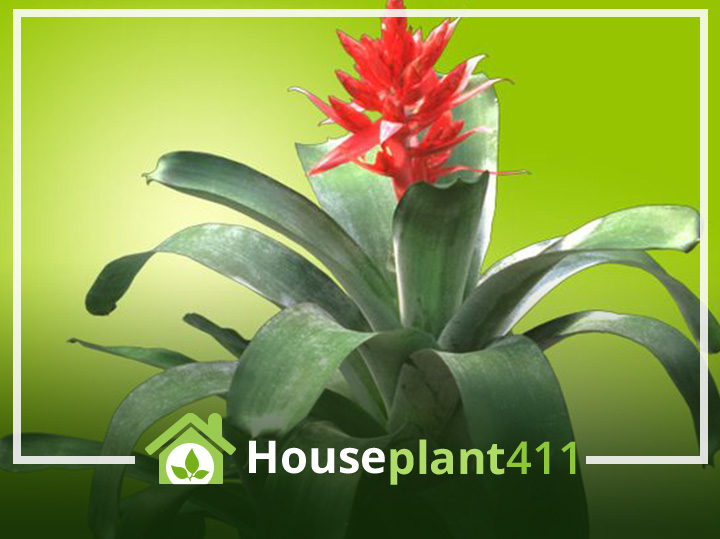If you’re tired of buying expensive cut flower arrangements for your dining room table or the reception desk in your office, think about using an easy care Bromeliad plant. There are over 2500 species of bromeliads that are native to North, Central and South America. My favorites varieties of bromeliads are: neoregelia, aechmea, and guzmania. A Bromeliad guzmania plant has long, thin, green. leathery leaves. Brightly colored flowers, really bracts, that can be red, yellow, orange, or even deep purple grow from the center of the plant. You can use a single bromeliad plant or combine three different bromeliads to create your own special arrangement. A bromeliad plant only blooms once indoors, then it’s necessary to propagate a new plant using offsets from the original plant.
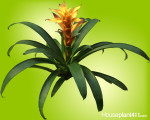
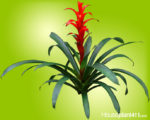
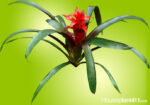
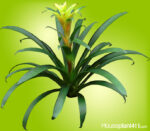
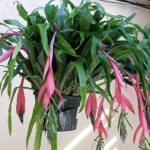
B. Marjan B. Rana B. Claret B. Sunshine B. Queen’s Tears
Plant Care
Light
A bromeliad plant is very adaptable to all types of light, and there is a bromeliad plant variety for every light condition. If your bromeliad plant has thin green leaves it can survive in low light. If a bromeliad plant has thick gray leaves, it needs medium light. The flowers (colorful “bracts”) of a bromeliad plant fade quickly and the leaves turn pale green when it’s placed in very bright light. The leaves of a bromeliad plant get further apart and turn dark green when the plant needs more light.
Water
Bromeliad plants are drought resistant succulents that like dry soil. A bromeliad plant has very small roots and over-watering is the number one reason bromeliad plants die. Some bromeliad plant varieties have “tanks” that like being filled with water; others varieties have fine hairs on their leaves that enjoy being misted.
Fertilizer
Feed a bromeliad plant by spraying a liquid fertilizer directly onto the leaves a few times each season. Dilute the plant food 1/2 to 1/4 the recommended strength. Never put fertilizer into the central cup of a bromeliad plant.
Temperature
Bromeliad plants are tropical plants that can survive in temperatures between 40F°-100°F (4.4C°-37.8°C) but prefer 70F°-75°F (21.1C- 23.9°C) during the day and ten degrees cooler at night. The blooms on a Bromeliad plant last longer when the temperature is cool.
Humidity
A bromeliad plant grows well in basic household humidity.
Flowering
Less intense light and cooler temperatures help the bromeliad plant flowers stay colorful longer. Indoors, a bromeliad plant blooms only once. As the bromeliad flower starts to die, the plant produces “pups,” baby plants, around the base of the mother plant. Cut off the dying flower, so the plant can direct its energy to helping the “pups” grow. You can use these “pups” to propagate a new bromeliad plant which will flower in about three years.
Pests
Scale and mealy bugs are a pest problem for bromeliads.
Diseases
Fungal plant diseases such as Crown, Stem and Root Rot, Rust disease, and Leaf Spot disease can infect the Guzmania variety of bromeliads.
Soil
Use a light, well-aerated, fast-draining soil for a bromeliad plant. Add sand or perlite to the basic soil mix if the soil seems too heavy.
Pot Size
During the spring, as a bromeliad plant matures and outgrows its existing pot, move the plant to the next size container. After 3 or 4 years, when a bromeliad has reached maturity, it is usually in an 8’ pot. Bromeliad plants like to be root-bound in small pots so don’t rush to put them into a larger container.
Pruning
A Bromeliad plant rarely needs to be pruned. If leaf tips turn brown, trim them with a sharp, wet scissors.
Propagation
Once the bromeliad plant flowers die, small plants called “pups” or “offsets” grow around the base of the plant. When these offsets are several inches tall, dig them out, getting as many roots as possible, and plant the baby bromeliads in a 4” pot of loose soil. Be careful not to over-water the new plants while the roots are developing. A newly propagated bromeliad plant usually blooms in 1-3 years.
Poisonous Plant Info
Bromeliads are non-poisonous houseplants.
FAQ
The blooms (bracts) on bromeliad plant last longer when the plant is kept in a cool, low light area. The warmer and brighter the room, the more quickly the color in the bromeliad plant flowers fades.
I wouldn’t recommend leaving a bromeliad plant sitting in water. Keeping the roots constantly wet is a perfect way to kill a bromeliad plant. Water well before you leave and place the plant in a cool, low-light area. The bromeliad plant may dry out a bit, but will survive until you return.
I think that putting water in the center cup of a bromeliad plant encourages bacterial and fungus infections. Water a bromeliad plant sparingly around the roots. Avoid using water that has passed through a softener or is high in fluoride, chlorine, or salt for a bromeliad plant.

